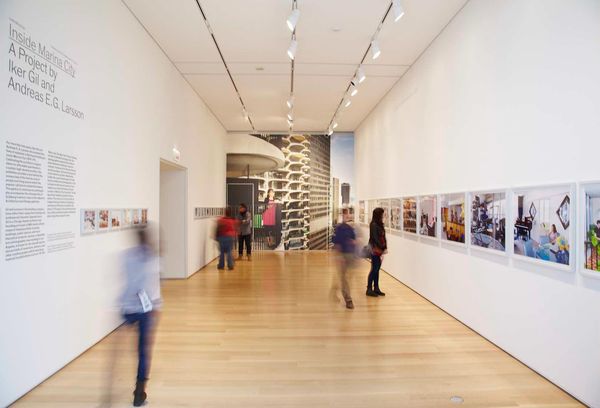As longtime residents themselves, the leaders of MAS Studio have become the de facto renovators of these unique apartments, redefining what it means to live in a building with working-class history.
There’s been much ado about the death of cities after the Covid pandemic, as businesses in downtown cores shuttered or went dormant. But in Chicago, the downtown "Loop" business district has seen massive growth as a residential neighborhood: A 2022 study by the Chicago Loop Alliance, a nonprofit neighborhood advocacy group, showed that the city’s downtown had added nearly 4,000 new residents since 2020. Yet concerns about affordability remain prominent as newer residential projects favor market-rate rents. Workforce housing, then, is pushed further out into the city’s sprawling neighborhoods or suburbs. Who gets to live in a transit-rich, walkable, and amenity-focused neighborhood has become a prominent tension.
This isn’t a new problem. Since the 1950s, when freeways tore through American cities and brought cheap, plentiful housing to suburban areas, urban cores were left dwindling. For working-class employees unionized with the Building Service Employees International Union in Chicago (a union of janitors and elevator operators), this meant expensive commutes from suburbs into their downtown jobs. In response, the union decided to invest in affordable workforce housing located downtown, financing what became Marina City. Known for its "corncob" shape designed by architect Bertrand Goldberg, the twin towers provided nearly 900 wedge-shaped apartments—narrow at the entryway, wider as you move inward—arranged around a concrete core. Each was outfitted with their own scalloped balconies, monochromatic interiors (in candy pink, custard, deep green, and more) and all-electric utilities. It was to be a "city within a city" complete with a movie theater, bowling alley, and restaurants. And it was popular: According to Chicago’s Landmarks Commission report, by the time the east tower opened in 1962, it had received more than 2,500 applications.
But that shine wore off. To stay viable, the building went condo in 1977, allowing tenants to purchase their units or buyers to rent them out. By the 1990s, an all-custard kitchen with an aging electric stove wasn’t desired for its midcentury vibe as it might be today; according to architect Iker Gil, the building was seen as run-down, with dated apartments towering above a floundering neighborhood. But as Chicago’s downtown has improved, Marina City apartments have again seen a resurgence: Gil and his partner Julie Michaels, who together lead the architecture firm MAS Studio, have lived in the towers for 20 years and have watched the building go from an architectural curio to a desirable place to live. As architects, they found themselves, unexpectedly, de facto renovators of these unique dwellings, attempting, in some ways, to use interior architecture to redefine what it means to live within working-class history. This isn’t to say that renting at Marina City today is cheap—smaller rentals range between $1,700 and $2,500, while for-sale units start around $235,000—but with a focus on preservation and selective restoration, MAS Studio is making owners of these units into stewards of the building’s worker-centric past.

Photo by Andreas E.G. Larsson, courtesy of MAS Studio
Gil and Michaels moved into Marina City in 2005. As renters, they sought out a one-bedroom "wedge" that hadn’t been renovated—many original tenants had purchased their units and ripped out the monochrome steel kitchen cabinets and replaced the black asbestos flooring with carpet; some had bought two adjacent wedges and upended the entire floor plan. Gil and Julie found a unit owned by one of the original 1960s tenants who kept her candy-pink kitchen and black floor; she agreed, they say, to allow them to do minor renovations on their own dime, bringing the unit back to its original sheen. They remained in their unit for 10 years and got to know other residents—many of whom had occupied Marina City since the beginning.
Residents—including renters—have a variety of incomes, says Michaels, mostly due to the building’s tiered pricing system, wherein units that are located on lower floors would be less expensive than those with skyline or lake views; those renting from owners could easily find cheap housing. "There are students who would treat a one-bedroom like a dorm room; there are a lot of blue-collar workers who work in the Loop," she continues. There are also wealthier owners who use an apartment like a pied-à-terre for the work week "then go back to their [suburban] home on the weekend," she explains.
Residents, says Gil, self-select to live in Marina City, and often stay there for many years; an internal ‘word-of-mouth’ marketplace for units allows longtime residents to trade up from a one-bedroom to a two-bedroom, or downsize to a smaller unit later, before anything goes on the public market. Renters can more easily become buyers. "You look at new housing that has other amenities, people are looking for granite countertops or a swimming pool. This building doesn’t offer that, so there’s a certain group of people that this building doesn’t fit," says Gil. "You see a diversity here that isn’t in other buildings that maybe also have an architectural pedigree."
Early into their tenancy, the couple began chatting with residents to understand what drew them to the building and how they’ve configured their lives within a pie-slice shaped apartment; later, these residents were photographed by Andreas E.G. Larsson. The photos, which were exhibited at the Art Institute of Chicago in 2011 and later traveled the country, depict a range of interiors: A unit furnished with a baby grand piano amongst ’80s furniture; a couple in a kitchen rehabbed with wood cabinetry. In some units, the original kitchen was still enclosed from the living room, in others, the kitchen enclosure was blown out. Some residents kept the original steel cabinetry but painted it white. "That was the idea: the value of this building is that people with different interests, different tastes, call it home," Gil says.

An exhibit featuring photos of Marina City residents debuted at the Art Institute of Chicago in 2011.
Photo by Andreas E.G. Larsson, courtesy of MAS Studio
At the exhibition opening, they happened to meet one Marina City resident looking to renovate their unit. For this project, titled MC01, MAS Studio worked with firm Ellipsis Architecture to peel back some of the spatial subdividing that the previous owner had done. "This was where we bring back some of the original idea about the flooring, to celebrate the structure, celebrate the view, and kind of keep it as simple as possible," says Gil. "We tried to express the structure, like there were areas where they had covered it," Michaels adds, pointing to the shapely recessed walls that are original to each apartment. They replicated the black flooring unique to Marina City units, using vinyl composite tile (VCT) instead of asbestos, and added sliding doors to the bedroom and storage to an interior wall; the resulting effect appears as a high-contemporary apartment wherein original vintage cabinets blend with new storage systems in a bright—albeit compact—one bedroom.

At the art exhibit, Iker Gil and Julie Michaels met fellow residents who would later ask them to do a renovation.
Photo by Tom Harris Photography, courtesy of MAS Studio
See the full story on Dwell.com: Chicago’s Iconic Marina City Is Having a Resurgence
Read More
By: Anjulie Rao
Title: Chicago’s Iconic Marina City Is Having a Resurgence
Sourced From: www.dwell.com/article/marina-city-towers-chicago-mas-studio-7f989c53
Published Date: Mon, 23 Jun 2025 16:03:46 GMT
Did you miss our previous article...
https://trendinginbusiness.business/real-estate/ocean-views-steal-the-show-at-this-7m-home-by-a-frank-lloyd-wright-apprentice
.png)





